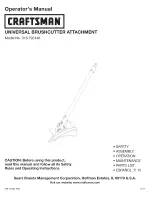
4
SAFETY
WARNING: When using electric tools, always follow basic safety precautions to reduce the
risk of fire, electric shock, and personal injury.
READ AND SAVE ALL INSTRUCTIONS FOR FUTURE USE
. Before use, be sure everyone using
this tool reads and understands this manual as well as any labels packaged with or attached to the tool.
1.
KNOW YOUR POWER TOOL
. Read this manual carefully to learn your power tool’s
applications and limitations as well as potential hazards associated with this type of tool.
2.
DO NOT ALLOW UNQUALIFIED PEOPLE TO OPERATE THE TOOL
.
3.
AVOID DANGEROUS ENVIRONMENTS.
Do not use your power tool in rain, damp or wet
locations, or in the presence of explosive atmospheres (gaseous fumes, dust, or flammable
materials). Remove materials or debris that may be ignited by sparks.
4.
KEEP WORK AREA CLEAN AND WELL LIT
. Cluttered, dark work areas invite accidents.
Provide at least 200 watts of lighting at the front work area of the tool. Eliminate all shadows that
could interfere with clear viewing of the work area.
5.
DRESS PROPERLY
. Do not wear loose-fitting clothing or jewelry. Wear a protective hair
covering to contain long hair, as it may be caught in moving parts. When working outdoors, wear
rubber gloves and insulated, nonskid footwear. Keep hands and gloves away from moving parts.
6.
USE SAFETY EQUIPMENT
. Everyone in the work area should wear safety goggles or glasses
with side shields that comply with current safety standards. Wear hearing protection during
extended use and a dust mask for dusty operations. Hard hats, face shields, safety shoes, etc. should
be used when specified or necessary. Keep a fire extinguisher nearby.
7.
KEEP BYSTANDERS AWAY
. Keep children and bystanders at a safe distance from the work
area to avoid distracting the operator and contacting the tool.
8.
MAKE THE WORKSHOP CHILD PROOF
with padlocks, master switches, etc.
9.
NEVER LEAVE THE TOOL RUNNING UNATTENDED
. Turn the power off. Do not leave
the tool until it comes to a complete stop.
10.
PROTECT OTHERS IN THE WORK AREA
from debris such as chips and sparks. Provide
barriers or shields as needed.
11.
USE THE RIGHT TOOL
. Do not use a tool or attachment to do a job for which it is not
recommended. For example, do not use the routers supplied with the machine for other manual
applications. Do not alter the tool or remove guards.
12.
CHECK FOR DAMAGED PARTS
. Inspect guards and other parts before use. Check for
misalignment, binding of moving parts, improper mounting, broken parts, and any other conditions
that may affect operation. If abnormal noise or vibration occurs, turn the tool off immediately and
have the problem corrected before further use. Do not use a damaged tool. Tag damaged tools “DO
NOT USE” until repaired. Repair or replace a damaged guard or other part. For all repairs, insist on
identical replacement parts.
13.
REMOVE ALL ADJUSTING WRENCHES AND TOOLS
from the tool before turning it on.
Make this a habit.
14.
GROUND YOUR TOOL
. When in doubt as to the grounding of your machine, consult a qualified
electrician before using your machine.




































